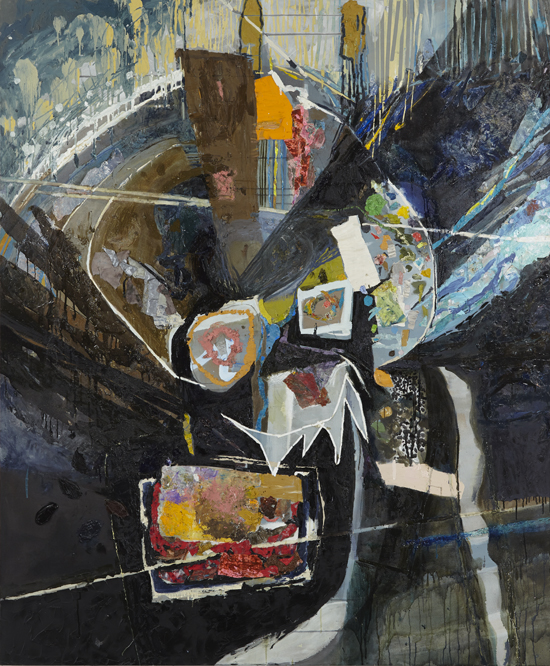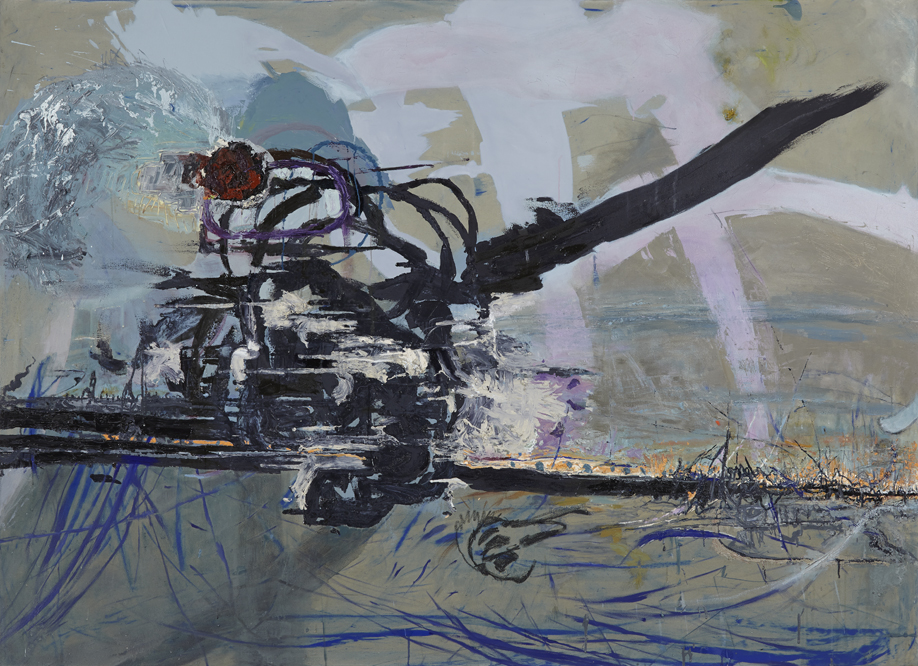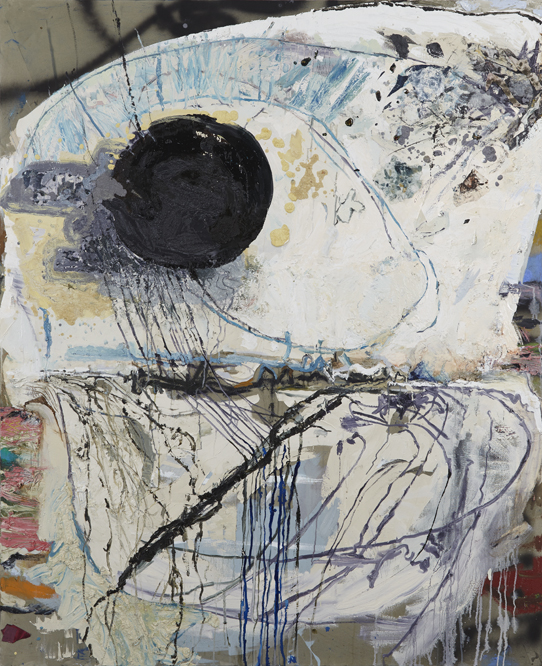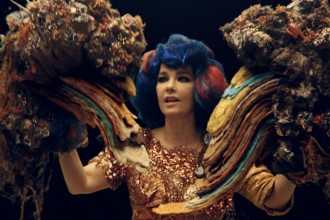Whatever specificity of place can be found in Susanna Heller’s paintings at Olga Korper Gallery shimmers with Wallace Stevens’s line, “Description is revelation. It is not / The thing described.” Working on an all-encompassing scale, Heller’s new suite of paintings “describe” landscapes that toggle between the exterior and the interior, and jostle with the movement of their lived experience. Known for her process, in which the Brooklyn-based Heller sketches on foot (often while walking towards Manhattan – but Toronto appears here, too), the resultant images have the quality of a handheld camera, if it could zoom inward as much as out, and factor in emotional turbulence just as the wind shakes the lens.
Korper cites depression as a main character in the work, and tells the story of how Heller wanted to name the show Trouble, but Korper insisted on Joy. (“I told her that, privately, we’d both know the actual title was Fucking Joy.”) Indeed, there is a Trouble in the exhibition, a barely-there cityscape in which a black sun – or a burnt-out eye – presides over its territory and swings a dripping line through its expanse. Heller has been through it, in recent decades. She conducted an artist residency in the Twin Towers two years before they were felled by terrorist attacks. She watched them burn from across the river, and knew several of the people killed. Her impulse, tellingly, was to walk toward the wreckage, sketchbook in hand. Because she wasn’t a photographer, she was able to get close to the site and record what she saw, pressing pencil to paper. She would exhibit her “tower” pictures a year later, also at Olga Korper’s, and describe the experience as vertiginous. “When I was making the big ‘Tower’ drawings I would stand with my nose against the glass and look down. Vertigo is the most melodramatic description of space you can have – it’s the baroque of space – and to make the work I needed to experience that vertigo.” These images mirrored the nightmares she was having, of being stuck on the 91st floor, and falling with the fire.
More recently, Heller’s husband of 23 years suffered necrotizing fasciitis, which ravaged his right leg, and required 27 operations over the span of three months. Reflecting on this in 2012, Heller told critic Sarah Milroy, “I do what I always do. I found survival on the tip of a pencil.”
Continuing one of art history’s most compelling traditions, Heller disturbs perspective with experience. The activity of observing her paintings mirrors the activity of looking, itself: the eye flits between foreground and background, and all other matter crashes around in-between. Lines sweep distances as when a storyteller interrupts herself to remind you of a relevant detail from the past. A landscape might line a brooding smash of internal life, grounding the image in something vaguely objective, and pulling it to just this side of abstraction. A city’s profile might hover like a heat shimmer, waiting to be seen. But Heller’s insistence on a continual presence – here you are, now here you are – is where her real subject lies.
To paint the activity of looking – and to account for its time – floats back to the late 19th-century, and strongly comes to bear in the Cubist period of the early 20th. These exercises haven’t lost their appeal for contemporary painters, of course. But our instruments have changed. In the early 1980s, after a successful twenty years of painting, David Hockney turned to the Polaroid camera and began photo-collaging (making what he termed “photojoiners”), in an effort to step out of the perspectival limits and demands of figurative painting, and account for the temporal, jockeying nature of looking itself.
I decided to interrupt my painting for a while to pursue the joiners and expected to stop when I got bored. The problem was that I didn’t get bored: it got more and more fascinating. […] I had begun a twenty-by-seven-foot painting of Santa Monica Boulevard. I used to walk up and down it, and the main problem was that it was seen from one point of view, essentially. I had struggled at that painting for six months, trying to make it look as though you were walking along. But when I started the joiners, I realized I could now paint the Santa Monica Boulevard picture another way. The joiners told me how to do it.
The artist’s attempt to capture both the experience of walking the city while accounting for one’s internal landscape has been pursued by poets, critics, philosophers, and artists, alike. Kierkegaard, Baudelaire, Proust, and Benjamin laid out the phantasmagoria and memorial affect, and later Guy Debord – all the way up to Toronto Star columnist Shawn Micallef – accounted for “pyschogeography,” and the subjectivity of urban mapping. Heller taps into a long history, then, and pursues its most essential themes and gestures.
In an interview with former AGO director, Matthew Teitelbaum, Heller was asked if place really matters to her. She replied, “I really don’t know how to say it intensely enough, but it’s not place that really matters to me, but city that really matters to me.
“I know it’s irrational, but that’s the beauty of painting! It’s a powerful place to show that non-rational layering and multiplicity of experience can and does exist at one time in one place and in a single viewer! [….] I think you even experience a painting that way: you see the way it looks, and then you wander into it and you get stuck in a little part of it and then you wander along, travel along. Then you step back again and see the whole thing differently, my paintings are meant to be watched in that kind of time.”
T.S. Eliot, in his Four Quartets, writes “Home is where one starts from.” As with any start, the implication is that we end up somewhere else. In Heller’s painting, where we arrive to is right here. Whether we’re breathing with her as we span the Brooklyn bridge, or peering out across Toronto’s skyline from the Scarborough bluffs, Heller affects the hereness of our internal place. However fraught, where we end up is where we are.


























I have a large number of Susanna’s pieces large and small – Toronto and New York. I think I appreciate her work because i am a big city person and love the multi-layered complexity of living in an urban environment. You captured very well in words how I feel when I look at Susanna’s work. Thank you for your taking the time to reflect.